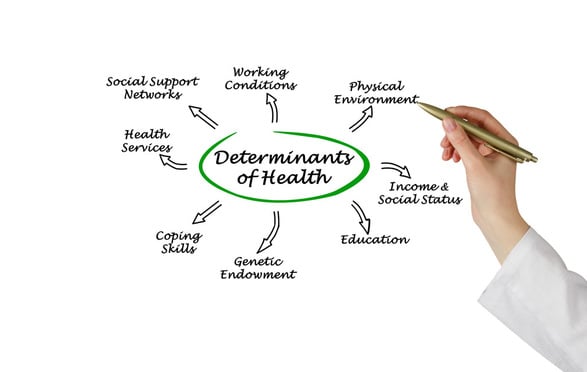Advertisement

Megatrend 1: Merging Of Payers And Providers—Amplifying Value-Based Payments
EMANUEL SAYS: "In 2014, in Reinventing American Health Care, I predicted the end of insurance companies as we know them. I imagined hospitals would move to fuse payment and delivery of care, supplanting insurers. I was wrong. It turned out that hospitals did not take the initiative to merge payment and delivery. They proved unimaginative and demurred from being the leaders of transformation. Instead, it was insurers that changed their nature and became the disrupters by moving into health care delivery. ... The success of this merging of payer and provider will further accelerate the replacement of fee-for-service by alternative payment models (APMs) that put risk on providers. Providers are the key to controlling costs and ensuring quality of care. After all, physicians control the decisions about hospital admissions and orders for tests and treatments. And hospitals control the efficiency of operations and negotiate commercial prices. If providers were to eliminate inefficient and unnecessary care, it is estimated the savings could range from $86.8 billion to $164.1 billion—about $250 to $500 per American. And if they were to provide more proactive care for patients with chronic illness, additional billions could be saved."(Photo: Bigstock)

Megatrend 2: Reducing Upcoding And Other Gaming Of Medicare Advantage
EMANUEL SAYS: "The gaming of Medicare Advantage (MA) has reached crisis proportion. Reports and estimates by the Office of Inspector General, the Medicare Payment Advisory Commission, the Committee for a Responsible Federal Budget, and others have documented extensive gaming and abuse. Collectively, they suggest that CMS could save from $20 billion to $35 billion per year by eliminating the structural overpayment to MA plans, systematic upcoding, quality gerrymandering, and other manipulations. ... [O]ne obvious and probable place for action is to revise or replace the hierarchical condition category (HCC) risk-adjustment model. It is outdated and needs to be retired. CMS is phasing in small changes to the risk-adjustment model, including getting rid of more than 2,000 diagnostic codes that are likely to be abused for upcoding. But there needs to be a better alternative—one that is more accurate and objective, ideally based on factors not dependent on clinical codes but on ones that are less manipulable, such as laboratory results, and imaging findings. A dynamic machine learning (ML) model using the same data that goes into HCC scores would be more accurate and less biased at predicting future costs."(Photo: Ngampol/Adobe Stock)

Megatrend 3: Ever More Automation
EMANUEL SAYS: "The health care system faces shortages of not just front-line physicians, nurses, and other members of the direct clinical care team; we also face shortages of myriad other upstream health care manufacturing workers, such as trained staff who produce CAR-T cells, and downstream workers such as attendants in nursing homes. ... Automation can be used not only to address shortages but also to remove some of the frustrating administrative work that is causing physician and nurse burnout and driving workers to leave the field in the first place. This would contribute to helping clinicians operate at the top of their license. Recent surveys suggest bureaucratic tasks and electronic health records (EHRs) demands as being among the top causes of burnout. ... Beyond improving provider workflows, integrating new automated technologies and digital tools in medical practice also provides an opportunity to reduce spending on administrative costs, which accounts for about one-quarter of US health care spending. By some estimates, reducing "administrative waste"—unnecessary spending related to billing or other corporate and operational functions—could save as much as $265 billion."(Photo: Elnur/Adobe Stock)

Megatrend 4: Hospital Closures And Concentration
EMANUEL SAYS: "Twenty seven hospitals closed in 2020 and 2021, and hundreds of rural hospitals are projected to close in the next few years. Other hospitals are cutting staff and closing departments. Even the big nonprofit hospitals—such as Cleveland Clinic, Mass General, and Providence—are bleeding red ink. Margins at the for-profit hospital systems are also being squeezed. ... By the end of the decade, probably 500 to 1,000 hospitals will close. ... There is something hospitals can do alone: change their business model. For the past few decades, hospitals made their money on highly compensated elective procedures. COVID-19 substantially reduced these procedures, and hospitals have not recovered. Precisely what has happened, and the reduction focused primarily on discretionary or unnecessary procedures, is not yet clear. Some services migrated to ambulatory surgery centers that have become more capable of complex surgical procedures. Regardless, over the next few years, hospitals will have to wean themselves off these procedures as the drivers of margin. Instead, they will have to conduct time-motion studies to focus more on improving efficiencies, not just on the clinical side but also on administrative functions (see megatrend 3 on automation). ... The industry will need to change business models and focus on efficiency. Beyond that, we will require leadership to convene multiple parties to develop solutions to persistent problems. The changes are unlikely to be completed in the next five years, but what the care infrastructure becomes will depend on many decisions made over this period. Regardless, a decline in hospital-based care is inevitable."(Photo: NVB Stocker/Adobe Stock)
Advertisement

Megatrend 5: Transformation Of Remote Patient Monitoring Into Remote Patient Management
EMANUEL SAYS: "Moving to remote patient management will require putting in place a three-part critical infrastructure: monitoring, which is data collection; analysis of data to identify reliable signals and clinically relevant, actionable insights; and management, the deployment of clinicians and clinical interventions to effectively alter patients' clinical course with standardized interventions. ... Such a comprehensive and seamless remote patient management system is not here yet. But the parts are coming together. There are sensors and ever improving analytic platforms. In addition, the Food and Drug Administration has given breakthrough device designation for a digital therapeutic for heart failure. Over the next five years, there will be many more advances in terms of sensors, analysis, and standardized management platforms. This is good for patients. It will allow for more convenient care from the comfort of patients' homes. It will be good for physicians by removing annoying noise and helping them manage patients with complex conditions. Additionally, remote patient management will reduce demand for hospital beds, avoiding crisis levels of care and costs. The trend to effective remote patient management in the home is inevitable. The rewards for hospital systems and start-ups that get it right will be substantial."(Photo: Andrey Suslov/Shutterstock.com)

Megatrend 6: Expansion Of Comprehensive Primary Care
EMANUEL SAYS: "[T]he tremendous growth of organized primary care groups focused on high-quality, comprehensive care at lower prices is unstoppable and will continue through the end of the decade. ... The best models will deploy the right infrastructure, including proactive care coordinators for chronically ill patients, integrated behavioral health services to manage growing mental health burdens, home health, same day appointments, extended office hours, telemedicine access, and standardized care pathways for common problems such as chronic obstructive pulmonary disease exacerbations. The best will also have most patients under value-based payments with substantial, salient incentives for cost savings, quality, access, and equity. (See megatrend 1, the irreversible trend to alternative payment models.) Finally, the best performers will provide individual physicians with information about high-risk, chronically ill patients so that they can be preemptively cared for. Physicians will also have information on recently hospitalized patients to be seen within seven days of discharge and will receive performance feedback and relative rankings so they know how to improve."(Photo: Lordn/Shutterstock)

Megatrend 7: Mental Health Parity
EMANUEL SAYS: "Increased demand, general public concern, and more access channels point to a trend that should finally culminate in mental health parity. Maybe the best sign that evolution toward parity will accelerate comes from the embrace by payers and providers. For instance, UnitedHealth's CEO, Andrew Witty, recently dedicated the company to 'integrating behavioral health' into value-based care offerings. CVS Health is including appointments with psychiatrists and therapists as a part of its virtual care service. Similarly, Blue Shield of California is integrating mental health care in its new virtual-first plan. And the large and growing provider group Advocate-Aurora has integrated behavioral health into hospital care for all Medicare Advantage patients. Expect this trend to continue."(Photo: jsmith/iStockphoto.com)

Megatrend 8: Improved Maternity And Newborn Care
EMANUEL SAYS: "Improving maternity care is finally being recognized as a major issue and is rising on the agenda for politicians, insurance plans, and health systems. This suggests that the US performance on maternity and newborn care can and, more importantly will, improve over the decade. ... A strong effort surrounding improving maternity care needs to address the entire pregnancy continuum, not just the moment of delivery. The country needs to set a goal of no unplanned pregnancies. Hence, universal access to birth control and abortion services should be a pillar in maternity care initiatives. Additionally, initiatives should begin pre-natal care before pregnancy. Stronger partnerships with primary care initiatives can ensure women are ready for a healthy pregnancy by managing and addressing hypertension, diabetes, substance and alcohol abuse—in essence, any risk factors that might put a patient and the infant at high risk during pregnancy. ... [T]ruly transformative progress is not guaranteed; for that to occur requires a concerted, coordinated, and most importantly sustained effort by hospitals, obstetricians, employers, commercial insurers, and Medicaid. These stakeholders must create and require participation in registries, implement payment and performance incentives, and adopt guidelines to achieve real progress. The good news is that for the first time in decades, the interest of government and payers makes a real maternal health initiative seem not just possible but probable."(Photo: Zoriana Zaitseva/Shutterstock.com)

Megatrend 9: Enhancing Critical Non-Health Care Services
EMANUEL SAYS: "Over the past two decades or so, interest in social determinants of health has revived, in part because a growing body of research has caused policy makers, payers, physicians, and others to realize how much use of expensive health care services is driven by social service deficits. A major push to address social determinants of health is now underway. Multiple factors are converging to alter behavioral and social factors to improve health outcomes. The Joint Commission has mandated that hospitals screen for social needs. Improved understanding of patients' social needs will create pressure to develop interventions to address them. One evolving intervention is hospital-based community health workers, an attempt by hospitals to connect patients to social services and decrease readmission rates. Beginning in 2020, the government allowed Medicare Advantage plans to offer non-health "Special Supplemental Benefits for the Chronically Ill," such as nutrition and transportation, to address social determinants of health. Similarly, numerous states—from Oregon and Arizona to North Carolina and California—are allowing managed Medicaid plans to pay for non-medical services. Finally, value-based payment models—especially those with downside risk—can incentivize health providers to pay for nutrition and other social determinants of health to reduce health system use."(Photo: arka38/Shutterstock.com)
Advertisement

Megatrend 1: Merging Of Payers And Providers—Amplifying Value-Based Payments
EMANUEL SAYS: "In 2014, in Reinventing American Health Care, I predicted the end of insurance companies as we know them. I imagined hospitals would move to fuse payment and delivery of care, supplanting insurers. I was wrong. It turned out that hospitals did not take the initiative to merge payment and delivery. They proved unimaginative and demurred from being the leaders of transformation. Instead, it was insurers that changed their nature and became the disrupters by moving into health care delivery. ... The success of this merging of payer and provider will further accelerate the replacement of fee-for-service by alternative payment models (APMs) that put risk on providers. Providers are the key to controlling costs and ensuring quality of care. After all, physicians control the decisions about hospital admissions and orders for tests and treatments. And hospitals control the efficiency of operations and negotiate commercial prices. If providers were to eliminate inefficient and unnecessary care, it is estimated the savings could range from $86.8 billion to $164.1 billion—about $250 to $500 per American. And if they were to provide more proactive care for patients with chronic illness, additional billions could be saved."(Photo: Bigstock)

Megatrend 2: Reducing Upcoding And Other Gaming Of Medicare Advantage
EMANUEL SAYS: "The gaming of Medicare Advantage (MA) has reached crisis proportion. Reports and estimates by the Office of Inspector General, the Medicare Payment Advisory Commission, the Committee for a Responsible Federal Budget, and others have documented extensive gaming and abuse. Collectively, they suggest that CMS could save from $20 billion to $35 billion per year by eliminating the structural overpayment to MA plans, systematic upcoding, quality gerrymandering, and other manipulations. ... [O]ne obvious and probable place for action is to revise or replace the hierarchical condition category (HCC) risk-adjustment model. It is outdated and needs to be retired. CMS is phasing in small changes to the risk-adjustment model, including getting rid of more than 2,000 diagnostic codes that are likely to be abused for upcoding. But there needs to be a better alternative—one that is more accurate and objective, ideally based on factors not dependent on clinical codes but on ones that are less manipulable, such as laboratory results, and imaging findings. A dynamic machine learning (ML) model using the same data that goes into HCC scores would be more accurate and less biased at predicting future costs."(Photo: Ngampol/Adobe Stock)

Megatrend 3: Ever More Automation
EMANUEL SAYS: "The health care system faces shortages of not just front-line physicians, nurses, and other members of the direct clinical care team; we also face shortages of myriad other upstream health care manufacturing workers, such as trained staff who produce CAR-T cells, and downstream workers such as attendants in nursing homes. ... Automation can be used not only to address shortages but also to remove some of the frustrating administrative work that is causing physician and nurse burnout and driving workers to leave the field in the first place. This would contribute to helping clinicians operate at the top of their license. Recent surveys suggest bureaucratic tasks and electronic health records (EHRs) demands as being among the top causes of burnout. ... Beyond improving provider workflows, integrating new automated technologies and digital tools in medical practice also provides an opportunity to reduce spending on administrative costs, which accounts for about one-quarter of US health care spending. By some estimates, reducing "administrative waste"—unnecessary spending related to billing or other corporate and operational functions—could save as much as $265 billion."(Photo: Elnur/Adobe Stock)

Megatrend 4: Hospital Closures And Concentration
EMANUEL SAYS: "Twenty seven hospitals closed in 2020 and 2021, and hundreds of rural hospitals are projected to close in the next few years. Other hospitals are cutting staff and closing departments. Even the big nonprofit hospitals—such as Cleveland Clinic, Mass General, and Providence—are bleeding red ink. Margins at the for-profit hospital systems are also being squeezed. ... By the end of the decade, probably 500 to 1,000 hospitals will close. ... There is something hospitals can do alone: change their business model. For the past few decades, hospitals made their money on highly compensated elective procedures. COVID-19 substantially reduced these procedures, and hospitals have not recovered. Precisely what has happened, and the reduction focused primarily on discretionary or unnecessary procedures, is not yet clear. Some services migrated to ambulatory surgery centers that have become more capable of complex surgical procedures. Regardless, over the next few years, hospitals will have to wean themselves off these procedures as the drivers of margin. Instead, they will have to conduct time-motion studies to focus more on improving efficiencies, not just on the clinical side but also on administrative functions (see megatrend 3 on automation). ... The industry will need to change business models and focus on efficiency. Beyond that, we will require leadership to convene multiple parties to develop solutions to persistent problems. The changes are unlikely to be completed in the next five years, but what the care infrastructure becomes will depend on many decisions made over this period. Regardless, a decline in hospital-based care is inevitable."(Photo: NVB Stocker/Adobe Stock)
Advertisement

Megatrend 5: Transformation Of Remote Patient Monitoring Into Remote Patient Management
EMANUEL SAYS: "Moving to remote patient management will require putting in place a three-part critical infrastructure: monitoring, which is data collection; analysis of data to identify reliable signals and clinically relevant, actionable insights; and management, the deployment of clinicians and clinical interventions to effectively alter patients' clinical course with standardized interventions. ... Such a comprehensive and seamless remote patient management system is not here yet. But the parts are coming together. There are sensors and ever improving analytic platforms. In addition, the Food and Drug Administration has given breakthrough device designation for a digital therapeutic for heart failure. Over the next five years, there will be many more advances in terms of sensors, analysis, and standardized management platforms. This is good for patients. It will allow for more convenient care from the comfort of patients' homes. It will be good for physicians by removing annoying noise and helping them manage patients with complex conditions. Additionally, remote patient management will reduce demand for hospital beds, avoiding crisis levels of care and costs. The trend to effective remote patient management in the home is inevitable. The rewards for hospital systems and start-ups that get it right will be substantial."(Photo: Andrey Suslov/Shutterstock.com)

Megatrend 6: Expansion Of Comprehensive Primary Care
EMANUEL SAYS: "[T]he tremendous growth of organized primary care groups focused on high-quality, comprehensive care at lower prices is unstoppable and will continue through the end of the decade. ... The best models will deploy the right infrastructure, including proactive care coordinators for chronically ill patients, integrated behavioral health services to manage growing mental health burdens, home health, same day appointments, extended office hours, telemedicine access, and standardized care pathways for common problems such as chronic obstructive pulmonary disease exacerbations. The best will also have most patients under value-based payments with substantial, salient incentives for cost savings, quality, access, and equity. (See megatrend 1, the irreversible trend to alternative payment models.) Finally, the best performers will provide individual physicians with information about high-risk, chronically ill patients so that they can be preemptively cared for. Physicians will also have information on recently hospitalized patients to be seen within seven days of discharge and will receive performance feedback and relative rankings so they know how to improve."(Photo: Lordn/Shutterstock)

Megatrend 7: Mental Health Parity
EMANUEL SAYS: "Increased demand, general public concern, and more access channels point to a trend that should finally culminate in mental health parity. Maybe the best sign that evolution toward parity will accelerate comes from the embrace by payers and providers. For instance, UnitedHealth's CEO, Andrew Witty, recently dedicated the company to 'integrating behavioral health' into value-based care offerings. CVS Health is including appointments with psychiatrists and therapists as a part of its virtual care service. Similarly, Blue Shield of California is integrating mental health care in its new virtual-first plan. And the large and growing provider group Advocate-Aurora has integrated behavioral health into hospital care for all Medicare Advantage patients. Expect this trend to continue."(Photo: jsmith/iStockphoto.com)

Megatrend 8: Improved Maternity And Newborn Care
EMANUEL SAYS: "Improving maternity care is finally being recognized as a major issue and is rising on the agenda for politicians, insurance plans, and health systems. This suggests that the US performance on maternity and newborn care can and, more importantly will, improve over the decade. ... A strong effort surrounding improving maternity care needs to address the entire pregnancy continuum, not just the moment of delivery. The country needs to set a goal of no unplanned pregnancies. Hence, universal access to birth control and abortion services should be a pillar in maternity care initiatives. Additionally, initiatives should begin pre-natal care before pregnancy. Stronger partnerships with primary care initiatives can ensure women are ready for a healthy pregnancy by managing and addressing hypertension, diabetes, substance and alcohol abuse—in essence, any risk factors that might put a patient and the infant at high risk during pregnancy. ... [T]ruly transformative progress is not guaranteed; for that to occur requires a concerted, coordinated, and most importantly sustained effort by hospitals, obstetricians, employers, commercial insurers, and Medicaid. These stakeholders must create and require participation in registries, implement payment and performance incentives, and adopt guidelines to achieve real progress. The good news is that for the first time in decades, the interest of government and payers makes a real maternal health initiative seem not just possible but probable."(Photo: Zoriana Zaitseva/Shutterstock.com)

Megatrend 9: Enhancing Critical Non-Health Care Services
EMANUEL SAYS: "Over the past two decades or so, interest in social determinants of health has revived, in part because a growing body of research has caused policy makers, payers, physicians, and others to realize how much use of expensive health care services is driven by social service deficits. A major push to address social determinants of health is now underway. Multiple factors are converging to alter behavioral and social factors to improve health outcomes. The Joint Commission has mandated that hospitals screen for social needs. Improved understanding of patients' social needs will create pressure to develop interventions to address them. One evolving intervention is hospital-based community health workers, an attempt by hospitals to connect patients to social services and decrease readmission rates. Beginning in 2020, the government allowed Medicare Advantage plans to offer non-health "Special Supplemental Benefits for the Chronically Ill," such as nutrition and transportation, to address social determinants of health. Similarly, numerous states—from Oregon and Arizona to North Carolina and California—are allowing managed Medicaid plans to pay for non-medical services. Finally, value-based payment models—especially those with downside risk—can incentivize health providers to pay for nutrition and other social determinants of health to reduce health system use."(Photo: arka38/Shutterstock.com)
Advertisement
In February of this year, two letters went out to Congress imploring lawmakers to take definitive steps towards reducing health care costs. Both letters shared a focus on value-based care. Ilyse Schuman, senior vice president of health policy at the American Benefits Council, urged Congress in a February 27 letter to "take bold steps to address the root causes of rising costs (including market consolidation, lack of competition, price and quality transparency and the prevalence of chronic conditions) and promote value-based payments." The letter goes on to state that "efforts by employers to pursue innovative strategies that improve the value of health care are hampered by inconsistent and incomplete quality metrics. Some employers are already providing quality reporting, or others are working toward that goal, but challenges remain. Federal programs can spur these efforts by adopting uniform measures across federal programs. Congress can promote consensus measures of value to incentivize value-based payments." Meanwhile, a letter sent earlier in the month by a dozen leading U.S. health care organizations—including the American Medical Association, the Health Care Transformation Task Force and the American College of Physicians—stressed that value-based payment reforms have generated "more than $17 billion in gross savings" for Medicare over the past decade and improved the quality of care for millions of patients. "As you consider your priorities for the 118th Congress, we ask that you continue to advance the transition to value-based health care," the letter states. This recent focus on value-based payments may be why it tops the "System and Payment Reform" section of Ezekiel J. Emanuel's latest list of "Nine Health Care Megatrends." Emanuel, the vice provost for global initiatives and the Diane v.S. Levy and Robert M. Levy University Professor at the University of Pennsylvania as well as an oncologist and world leader in health policy and bioethics, first identified a number of trends in a book he wrote eight years ago called Reinventing American Health Care. These new "megatrends" are intended to follow on the trends outlined in the book, he writes, and ones he believes "will characterize US health over the rest of this decade." "As with everything, how these trends play out—especially how extensively and rapidly they are implemented and develop—will depend on government action, the overall economy, and commitment by those in the health care industry," Emanuel says in his introduction to the list. "As I discuss, not all of the trends I predicted in 2014 developed in the time frames I envisioned. But in my judgment, the trends I lay out in this article represent what is likely to happen. "If these nine megatrends turn out to be even partially correct, the US health care system—and most importantly patients—will be much better off at the end of the decade than today. We can all look forward to that," he concludes. The above slideshow summarizes Emanuel's nine trends, along with highlights from his commentary. Related:
NOT FOR REPRINT
© 2025 ALM Global, LLC, All Rights Reserved. Request academic re-use from www.copyright.com. All other uses, submit a request to [email protected]. For more information visit Asset & Logo Licensing.
Richard Binder
Richard Binder, based in New York, is part of the social media team at ALM. He is also a 2014 recipient of the ASPBE Award for Excellence in the Humorous/Fun Department.







